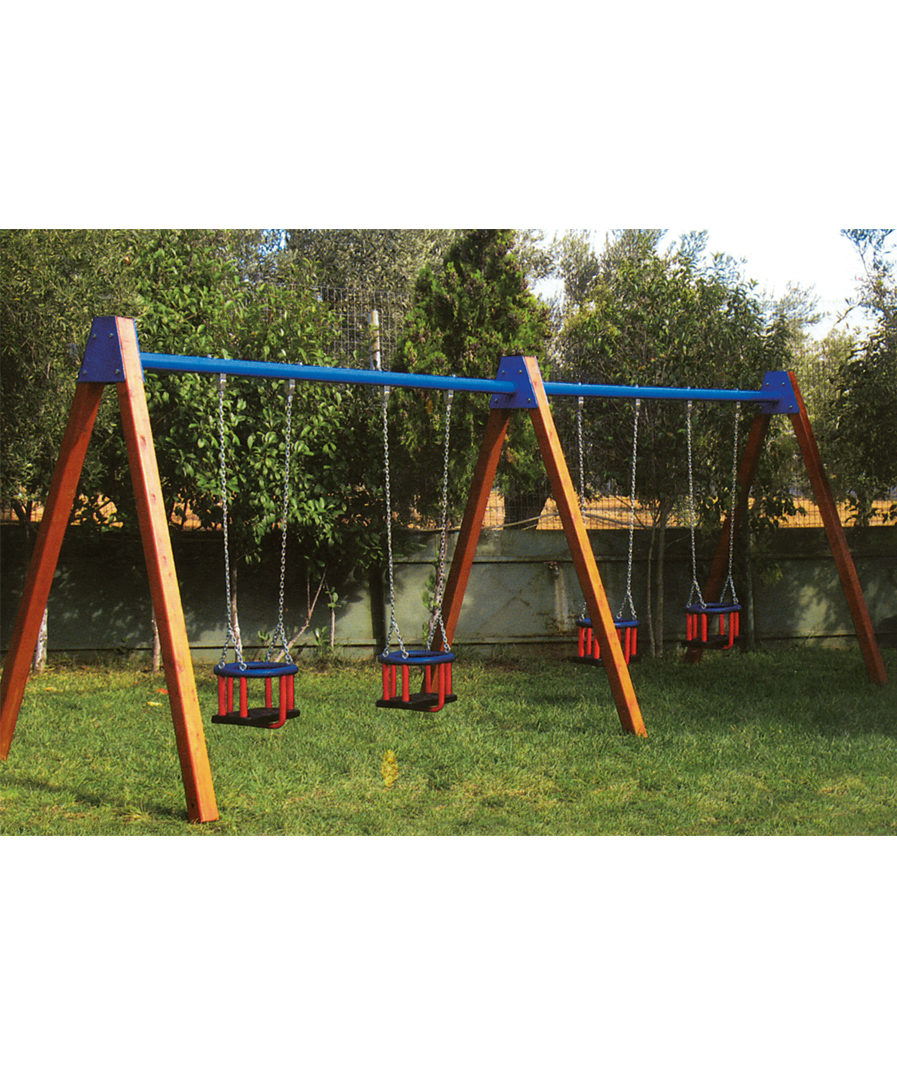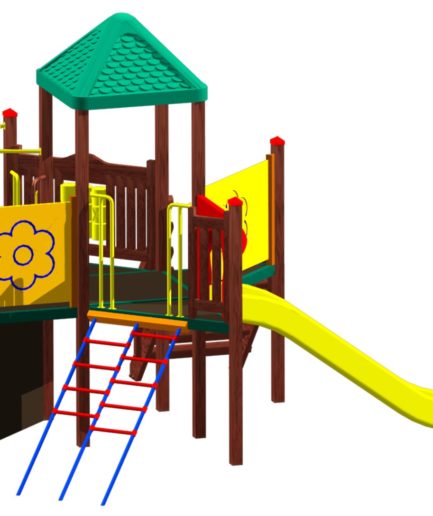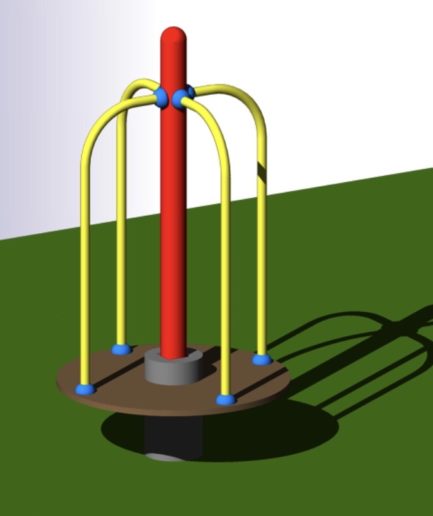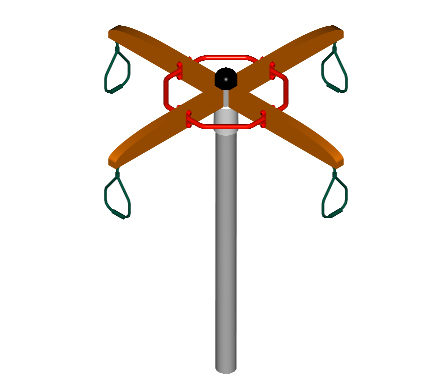SWINGS 0010-233Ν
0010-233N
The four-seater infant swing has dimensions: 210 cm high and 563 cm wide and requires a seat belt of 750×600 cm. It consists of two horizontal hot-dipped metal beams Ø 2.5 ″ and 260 cm long, ending at each end in 8 mm trapezoidal flange thickness. Six sloping beams of 9x9cm cross section 220cm long each connected in two “L” shapes on each side and one in the middle of the swing. Two trapezoidal flanges similar to the horizontal beam flanges, approximately 3 mm thick at both ends of the construction from the outside, facing the horizontal beam support flanges.
The flanges at the ends of the horizontal beam are connected to the sloping beams and 3 mm thick flanges with four M12X35 mm screws and safety nuts.
The 9X9X220c inclined support beams are joined to form an isosceles triangle with a base of 177cm and a side length of 220cm.
The horizontal metal beam is mounted on four bearings in specific dimensions (both between them and the sloping beams). The couplings are arranged in pairs leaving a gap (between pairs) of 55 cm and of the end of the swing 48 cm. The intermediate gap between the two pairs is 54 cm, based on EN 1176.
To attach the chain to the coupler, nautical keys are used, which secure with a safety nut. For joining the chain to the seat at the other end of the chain, nautical keys are also used.
The flat seat is of heavy construction type, is internally made of 345 MPa (91 mm) flat steel plate (50,000 psi) and has 8 mm diameter molded metal joints made of 304 stainless steel with 586 Mpa. 85,000 psi). The exterior of the seat is made of soft, comfortable black rubber.
They are slow ignition and provide high resistance to various chemicals. They are with UV stabilizers and provide antistatic protection.
On the sloping beams are mounted 9x9x65 cm mounting brackets with 5 / 8×110 mm bypass screws. and a depth of 60cm. on the ground where the swing is to be mounted and the mounts are mounted in. The dimensions for opening the pits are accurately shown in the Installation drawing.
Fill the cavity with a cement up to 40cm. and the rest with the soil we removed during the pit excavation. The crib is ready for use after 48 hours. To avoid using it before 48 hours, we may not use the seats.
An important detail of the flooring is that the timber should not be touched to the ground so as not to be eroded by soil moisture. Only ground mounts are fastened to the ground. Above them there is the Ground Line. It is a line beneath which the soil with which we filled the sump should not be removed.
Lifting is not required for the swing. For better and easier use of the swing by the users, the best location for mounting it is the northwest. When in this position, users are not blinded by the sun.
TIMBER
The wood used is Swedish pine composite non-stick wood, in accordance with EN 351. It is manufactured with special compound (welding) in different sections depending on the intended use.
COMPOSITE wood is 40% stronger than whole wood.
It has a strength of kp / m2 = 360 and a specific gravity of about 480 kg / m3.
It contains about 15% moisture.
It has thermal conductivity s = 0.10Kcal / Mho and sound insulation 3.5 times greater than concrete or bricks of equal thickness.
It has antimagnetic properties and is a poor conductor of electricity.
It is resistant to fire and is classified in categories F30 and F60 (by DIN 4102) according to its cross-section.
When the outer part of the cross-section is burned, its interior protects and retains its strength.
It is processed like the wood of commerce.
It retains its shape and is slightly deformed or cracked.
Annual wood rings are usually perpendicular to the long side of the cross-section with a significant increase in the mechanical strength of this surface, if applied to floors.
PLASTIC INFORMATION
The plastic components required to manufacture the equipment are highly resistant to UV radiation and adverse weather conditions. Preferred are recyclable materials such as polyethylene (PE) or polypropylene (PP). Specifically all screws protruding from the equipment over 5 mm are covered with polypropylene (PP) plastic plugs. They are also safe for the safety and health of children.
METALLIC ELEMENTS
The metallic elements used in the manufacture of the equipment (screws, connectors, etc.) are made of metals either thermo-galvanized or electro-galvanized, where the surface preparation has been preceded by sandblasting or stainless steel. The dimensions and cross-sections of the metallic elements are sufficient to accommodate (with an appropriate safety factor) the loads for which they have been designed to withstand corrosion and adverse weather conditions.
PAINTS
The varnishes and the colors that protect the wooden parts are specially designed for the climate of our country (temperature changes, open or closed areas etc.) are completely harmless to the users (they do not contain lead, chromium, cadmium and other heavy metals). ) and give great durability to our constructions.
For their anticorrosive protection, the metal parts are processed to release them, followed by a coating of polyzinc (zinc) and then electrostatic, two-layer polyester powder coating.
PACKING
The following procedure is used for fixing the equipment:
At this point where the column is to be placed, an 80 cm deep pit is opened. about 60cm in diameter. Then, once the column is inserted, the pit is filled with frusto-concreted concrete until it reaches 10 cm. from the ground surface, where it is covered with soil.
Only ground irons, which hold each column at a distance of about 10 cm from the ground, are prevented on the ground in order to prevent the wood from corroding the soil moisture.






